by Winding Pathways | Aug 6, 2020 | (Sub)Urban Homesteading, Flowers/Grasses, Garden/Yard, Garden/Yard
Learning from the Prairie
Wow. It’s August! We recently completed a management step on the prairie planted in early June. Weeds were outgrowing infant prairie plants that need sunshine. We buzzed off the weeds at the highest setting possible on our battery-powered cordless EGO mower.
We bought this mower because its battery powers a powerful electric mower that easily cuts tough grass while producing less emissions than a gas mower. And, it’s easy to use. No cord pulling to start it. Also, the mow height is simple to set and allows us a high setting that helps with prairie management.
-
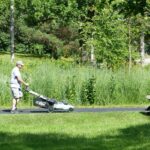
-
The mower and wheelbarrow.
-
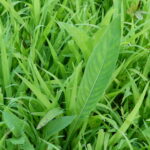
-
Prairie plants among grass.
-
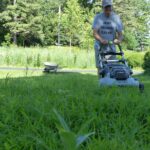
-
Emerging prairie plants will get more sunlight when the competing grasses are mowed off
Afternoon Delight
We planted a prairie in front of the house nine years ago and now spend hours sitting on the front porch reading and talking but always watching the prairie. Here are observations that make us delighted we converted a lawn to the prairie:
- Stunning beauty. We enjoy a changing array of colorful flowers and grasses that dance in the breeze. Coneflowers have been in bloom for a while. Milkweed blooms have faded. And, cupplants are just now coming into their midsummer glory.
- Insects. Monarchs and swallowtails cavort over the prairie on sunny days while stopping to sip nectar. Each evening the air over our prairie swarms with delightful lightning bugs. They are absent over the nearby lawn.
- Wrens, bluebirds, and goldfinches. A pair of wrens nested in a box just above our porch chairs. We love watching these industrious parents make trip after trip foraging for insects to feed the youngsters. They hunt in the prairie and nearby woods edge but not in the lawn. Our prairie enables our yard to support at least four pairs of nesting wrens and one pair of bluebirds. If the entire yard were mowed, we’d be lucky to have one wren couple to enjoy. In mid-summer goldfinches work the prairie.
- Garter and brown snakes. We’ve noticed an increase in garter and brown snakes, both harmless species as beautiful and interesting as goldfinches or cardinals.
-
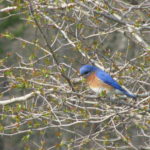
-
Bluebirds hang out on branches.
-
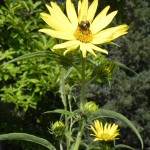
-
This hardy late season bloomer is vital for pollinators and migratory birds.
-
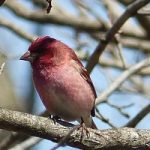
-
Some birds homestead at Winding Pathways.
Phoenix Harmony Labyrinth Prairie
Marion crafted a labyrinth through our oldest prairie on the front yard. She welcomes anyone to walk its circular path. Contact us before you come. The labyrinth is a peaceful way to access the prairie and contemplate the beauty of our earth while walking along its path.
-

-
People call and stop by to walk.
-
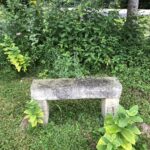
-
Visitors can rest and watch the prairie labyrinth.
-
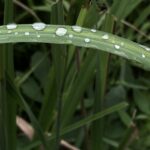
-
Prairie plants capture dew.
-
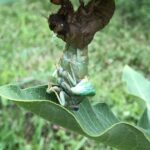
-
A rare treat is watching insect life emerge from one stage to another.
-
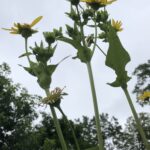
-
Cupplants hold water near their stem. Birds and insects sip
-
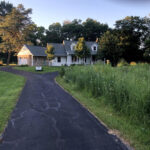
Make Like a Buffalo
When Sustainable Landscape Solutions did ground preparation for our new prairie, I asked Sean Pearl if he’d create two “artificial gopher mounds” in an older prairie in our backyard. He said “Sure.” A while back, we had planted this prairie with just grass seed. It has few flowers, and the roots of the big bluestem, Indiangrass, and switchgrass are tough and dense. Prairie needs disturbance. Once bison wallowed and gophers dug to create bare earth. Many prairie grasses need this bare earth to reseed. We had neither bison nor gophers so used a machine to create bare soil.
Sean’s machine chopped through the grasses. We followed up by planting 82 flower species seeds. Flowers add diversity, color, and attract pollinating insects. Looks like it’s working. Lots of new prairie wildflowers are growing in these two places in the midst of towering grasses.
Our next Prairie Renaissance blog will come in early fall.
by Winding Pathways | May 15, 2020 | (Sub)Urban Homesteading, Flowers/Grasses, Garden/Yard, Garden/Yard
Moving Forward
Once we made the decision to convert about 3,000 square feet of our lawn to a prairie, we began active planning. We have 40 years of prairie establishment and management experience so it was easy for us, but we still needed help and sought partners.
We contacted many organizations and found support for our project from these people and groups:
Sustainable Landscape Solutions, a business based in Iowa City. We hired them to do ground preparation. Sean Pearl is the owner.
Monarch Research Project, an active Cedar Rapids-based group that encourages pollinator plantings.
Linn County Secondary Roads. Since our prairie is near a Linn County road we wanted their support.
Pheasants Forever. We received help from a biologist, Allie Rath, and bought an outstanding seed mix from Pheasants Forever. Matt O’Connor manages the seed store and encouraged us to buy a Leopold Mix that contains about 72 species of flowers. Our seeds were produced at the Allendan Seed Company in southern Iowa.
Good Neighbor Iowa. This organization encourages people to shun lawn chemicals and plant native vegetation. A key contact is Audrey Tranlam.
Requirements
We wanted the prairie to be diverse in plant species, establish as rapidly as possible, and be “short profile”. Meaning we did not plant tall big bluestem, Indian grass, and Switchgrass.
We chose the Leopold mix because it has a diversity of flowering plants. And, Pheasants Forever kindly removed the tall-growing grasses from the mix for us.
Preparing and Seeding
Years ago when we began restoring prairies at Indian Creek Nature Center, it was impossible to buy seed, and little was known about how to establish a healthy native grassland. The Center had no money to invest in planting. Jock Ingels was a savvy restorationist based in Illinois. He gave us this advice, “If you don’t have any money but want a prairie, go pick some seeds and broadcast them into the existing lawn. Then burn it. Then wait. You’ll think you wasted your time because nothing will show after a year or even two years but burn it annually. By the third year, you’ll see prairie plants appear and it will get better each year after.” He was right. We gathered seed, planted at the Indian Creek Nature Center, and burned it annually.
At the Nature Center, we got a prairie at no cost and avoided herbicides and ground preparation but it had a limited diversity of species. The newly established prairie was far healthier ecologically than the bromegrass that was once there. For the prairie we wanted to establish at our home, we wanted a more diverse prairie and more quickly. So, we chose a faster method. Mind you, we are not keen on sprays but recognize they have a place.
Sustainable Landscape Staff sprayed our lawn with roundup in late April to kill the grass. They returned one week later and resprayed it to kill the remaining grass.
-
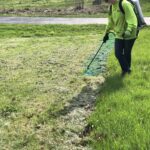
-
Caitlin carefully applies spray.
-
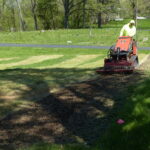
-
Tilling up the lawn.
-
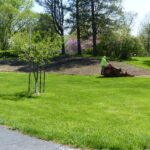
-
Finishing the edge.
-
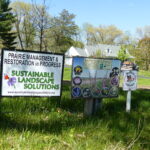
-
Three cooperators’ signs.
They returned a week later and rototilled the area to expose the soil. Spraying and tilling allows newly planted native seeds to grow with less competition from exotic lawn species. It emerges as a more diverse prairie faster than if spraying and tilling are avoided.
In the next installment of this series, we’ll show photos of us seeding the prairie and explain various other ways of establishing a prairie or pollinator meadow. But because lawns are now growing and people are mowing we’ll leave with this thought:
There’s a no-cost method of diversifying a lawn that reduces work. Simply mark off a section of the lawn and don’t mow it. It can be small. Many native plants have durable seeds that remain dormant in the soil for years or decades. They can’t succeed with constant mowing, so to increase plant diversity simply stop mowing a section of lawn and try to identify the new plants that emerge. You will help pollinators.
There’s a new phone app that we’re using to help identify plants we’re not familiar with. It’s called SEEK and is produced by the National Geographic Society, the California Academy of Science, and other groups. It’s free and can be accessed from the app store. You point the phone at a plant, insect, bird, or even a fungus, click a photo, and SEEK will identify it for you. It’s mostly accurate.
by Winding Pathways | Apr 2, 2020 | (Sub)Urban Homesteading, Foraging, Garden/Yard
Our Yards Offer Nutrition
Every spring we look forward to eating delicious, free, wild greens that grow in our yard and just about every place people live. Having an ability to identify, pick, prepare, and eat wild foods gives us some comfort in this age of uncertainty.
We encourage everyone to boost their backyard food production through gardening, backyard chickens for those who can keep them, and foraging. Here are a few things to consider before picking and eating any wild plant.
- Make sure you’ve identified the plant correctly. Use two sources to confirm identification. These might be an expert forager and a book or Internet source or a combination.
- Make sure the plants have not been contaminated by pesticides, animal feces, or vehicle exhaust. It’s best to forage away from busy roads. Wash plants thoroughly before preparing.
- Eat just a small portion the first time. Although it might be fine food for most people there’s a chance you might be allergic to it.
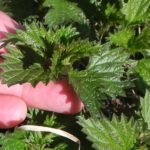
Carefully pluck the top three leaves off.
The key to enjoying all wild greens is to harvest them when they are very young. Many edible wild plants are tender and delicious shortly after they sprout but soon get coarse and bitter as warm weather stimulates their growth.
Nettles, sometimes called stinging nettles, live in moist places near streams, ponds, and woods, where they seem to prefer light shade. We have a couple of patches in our yard. They green up early in the spring, and we pick them before they are ten inches tall. We carefully pick just the top three or four small leaves. Remember these are stinging nettles. Wear light gloves or carefully pinch the top growth off the plant between the thumb and index finger. About a hundred leaf clusters make a great dish for the two of us. Rinse the nettles and boil them for a few minutes. The stinging part is a protein that dissolves in boiling water. We put a dab of butter on the drained cooked nettles and drink the water as a delicious spring tea.
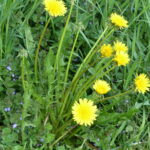
By mid-summer dandelion leaves are tough and bitter.
Because of herbicide companies’ promotions, just about everyone dislikes dandelions. Some have heard that dandelions are edible. It is true and, we need to thank our European ancestors for bringing dandelions to the New World. Otherwise, they might not have survived. They are high in vitamin A, folate, vitamin K, and vitamin C and a good source of calcium and potassium. Today, folks from Mediterranean countries grow and harvest dandelions as crops. They are a popular dish in Italian communities.
The few people who have tried eating them make the mistake of picking mature leaves in mid-summer. By that time, they are bitter and inedible. The best dandelion leaves are those picked in early spring and have been under a blanket of leaves. They’ll be partially blanched and delicious. It’s fine to pick small young leaves that can be added to salads if they are not too bitter. If they are bitter, boil two pots of water. Put the leaves in one pot and boil for a couple of minutes. Drain and put them in the second pot of boiling water and boil for another minute or so. The boiling removes the bitterness. Drain and enjoy with butter and salt and pepper.
This is a year of great anxiety and having some knowledge of how to find free food nearby can remove some of that concern.
by Winding Pathways | Mar 19, 2020 | (Sub)Urban Homesteading, Garden/Yard, Nature
Stuck at home? A tiny microbe is sure changing the lives of people worldwide. Unexpectedly, meetings and schools have closed and transportation is disrupted as uncertainty runs rampant. With every challenge comes an opportunity. We’re sticking close to home at Winding Pathways but are using more time around the house to do fun things and accomplish projects ignored during normally busy lives.
In the midst of uncertainty, it’s easy to be overwhelmed by events and suffer from lethargy and fatigue. That comes with the turf. So, being physically and intellectually active helps ward off melancholy.
With millions of kids now home with parents and other workers and retired folks staying closer to home and in apartments, here are a few productive activities we suggest. Anyone anywhere can engage in at least some of these activities. And, Winding Pathways invites you to create your own generative ideas to boost your immune system and help us all through this challenging time.
Attune to and with nature.
- Research affirms that contact with nature is calming and healing. Shinrin yoku also known as “forest bathing” is a way to connect with calming elements in nature. This concept extends far beyond the literal interpretation of a forest. Any natural area of any size can provide healing benefits. John Muir wrote it well:
“Climb the mountains and get their good tidings. Nature’s peace will flow into you as sunshine flows into trees. The winds will blow their own freshness into you, and the storms their energy, while cares will drop away from you like the leaves of Autumn.”
By connecting with nature wherever we are, we can learn and have a good time, too.
-
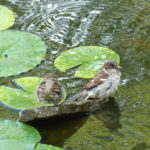
A water source helps attract birds.
Birding: Even in the biggest cities birds abound. Sparrows and pigeons are fascinating. Look closely at a group of birds hanging around the balcony or out the back door and soon you will note individual differences. Size. Shape. Behaviors. One sparrow, for example, may have an unusually colored feather while another has a twisted beak. Once you can identify individual birds, it’s possible to conduct simple research. Do the birds seem to hang out with their friends?
If odd feathered sparrow #1 seems to like being with crooked beak sparrow #2 maybe they are friends……or perhaps mates. How many different species of birds come to the Balcony or yard? You might be surprised. Look up. Spring is migration season and millions of big birds are heading north. Often their route takes them even over big cities. They often fly high so look with “soft eyes” for undulating strings of birds aloft.
Experiment. Put a birdseed mix in a feeder or even on a backyard table or the ground. What seeds do birds prefer?
- When the virus appeared, plants remained in winter mode across much of the country, but spring is fast approaching in the northern hemisphere. Now is a great time to keep a journal, or a simple list of the order in which buds swell and leaves emerge.
Gardening
-
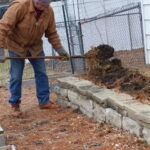
Work the garden to connect with the earth.
Gardening is a great remedy for stress, and it can yield a surprising amount of food, even in a tiny space. One of the best vegetables for kids to plant is the humble radish. These cold, hardy, spicy roots can be planted very early in the spring and often harvest comes in just a few weeks. Lettuce, chard, spinach, and other greens also can be planted early, but beans, tomatoes, corn, okra, squash, and many other veggies need to wait until winter’s frost is just a memory.
Take a walk
- Nature is pretty safe from Coronavirus. It doesn’t lurk in the woods. Poke around the yard. And, a ramble in a nearby park, woods, or along a trail is a stellar way to spend a few hours.
- Another option is to find a labyrinth outside to walk. The World Labyrinth Locator lists labyrinths across the world. A labyrinth is different from a maze. Labyrinths are designed to help people center, release what is on their mind or in their heart, receive inspiration, and reunite with their community in a positive way.
Connect Virtually
- Isolation isn’t fun. Call friends. A phone call is a great way to cheer a friend. And, check in with neighbors you rarely see. Think of ways to direct the conversation to the positive. Live the positive through regular practice. What does this do? Read below.
Practice Mindfulness
-
- Mindfulness is the ability to be present and aware of our thoughts with curiosity and kindness. Jon Kabat-Zinn provides excellent guidance on this. We practice this with adult students at Kirkwood Community College. To a person, they find benefit in reducing blood pressure, anxiety and heart rate, while their sense of calm increases.
- Another form is HeartMath which helps people focus first on breathing, then on creating a peaceful place in their mind that they feel in their heart and can return to anytime when under stress.
- Reduce time on social media and listening to reports on radio or television. Keep abreast as needed and avoid perseverating on the negative.
- Think and behave positively. Norman Vincent Pearle was a master at helping us shift into the positive.
- Laugh! Laughter releases positive hormones and neurotransmitters. An easy way to remember this is to give yourself a good DOSE of levity and positivity. Dopamine, Oxytocin, Serotonin, and Endorphins. These counteract the stress hormones. How can we do this? Read jokes, watch funny films or old TV shows that make you laugh.
-

Healthy foods are important in this time of stress.
Eat Healthily. When we are under stress, we tend to eat more and the wrong foods. So, mind what you eat, drink water, and try some of these activities above and add your own.
-

Reading positive literature will help us.
Read Entertaining Materials. From Comic books to graphic novels to non-fiction, engage your brain, learn and go lightly through this time. Share an engaging article, book, poem or song with someone. Recently The Gazette featured a woman, Mary Fannie Woodruff, from Virginia who continues to bake pies at 103 years old! How cool is that? The article was a great read we shared with family in Virginia.
We have many ways that we can all move through this uncertain time and help each other out on this winding path of life.
by Winding Pathways | Mar 12, 2020 | (Sub)Urban Homesteading, Garden/Yard, Garden/Yard
Like millions of Americans who live in rural or semi-rural areas we don’t have access to a city sewer and rely on our septic tank to safely dispose of waste. We’re lucky at Winding Pathways. Our home is built on an ancient sand dune with steep topography. It’s perfect for a septic system.
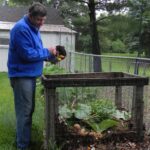
We put scraps that chickens will not eat into the compost bin.
As a review, we’ve been spared septic tank problems because we treat our system carefully. Here’s what we do:
- Only human and sink waste goes down the drain. Potato peels, apple cores, and all other food waste go either to our chickens or into the compost bin. Spring and fall, we work the compost into the garden soil.
- Have our tank pumped every three or four years.
- Avoid draining harsh chemicals, like bleach and solvents, into the tank.
- Use water-efficient toilets, showerheads, and sink aerators to limit the amount of water going into the tank.
In August 2019, we blogged in detail about maintaining a septic system. Since then, many readers have come to that blog. Especially this winter. So, we are curious.
What brings you to Winding Pathways? What topics interest you most? Why? What else would you like to read about?
Thanks for keeping us company on Winding Pathways and happy reading as winter winds down and spring manifests itself across the Northern Hemisphere.
by Winding Pathways | Feb 20, 2020 | (Sub)Urban Homesteading, Garden/Yard, Garden/Yard, Labyrinths, Nature
When we moved into our home ten years ago, we ended up with more than a house. The former owner had regularly mowed most of our two acres. Within the next two years, we shrank the lawn by about half. A steep former lawn north of the house is now prairie and a fairly level quarter acre between our house and the road is Marion’s labyrinth that she created within a prairie we planted.
Today, most people call flower-studded prairies “pollinator patches” and interest is strong in transforming lawns into them. Here are just a few of the good reasons:
Why Plant Pollinator Patches?
- Color: Lawns are a monoculture of green. Pollinator patches feature three seasons worth of changing vibrant color as many species of wildflowers come into and go out of bloom. They are beautiful.
- Water: Closely mowed lawns don’t absorb rain well. Much of a storm’s water runs off, worsening flooding. In contrast, deep-rooted prairies channel most of a storm’s water into the soil, where it eventually recharges the water table and doesn’t worsen downstream flooding.
- Labor: We don’t enjoy endless hours walking behind a lawnmower. We will mow our newly planted prairie two or three times this summer and in the following years, we won’t mow it at all. The lawn takes about a dozen mows a year. So, we’re saving time and mower gas that costs money and creates carbon dioxide.
- Wildlife: We love watching our wren pairs forage for insects in our pollinator patches. By expanding our prairie we’ll welcome even more beautiful and interesting beneficial wild animals to our yard.
Partnerships Work!
Our new prairie will be close to busy 30th St. Drive, so motorists cruising by will see the land transform. We’re partnering the project with the Monarch Research Project, Linn County Roadsides, Sustainable Landscape Solutions, and Pheasants Forever.
Many people want to create pollinator patches in their yards but don’t know how to do this. We will be blogging through the process to help folks know how this is done. Stay tuned and keep visiting www.windingpathways.com to learn how.
-
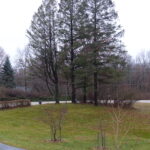
-
The heavy, up-slope clay soil will absorb water more efficiently and reduce runoff.
-
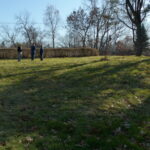
-
The crew from Sustainable Landscape Solutions determine soil type
-

-
Winding Pathways, Linn County roadsides, Pheasants Forever, the Monarch Research Project and Pheasant Forever make a strong partnersjhip demonstrating how to improve the quality of the land.
-
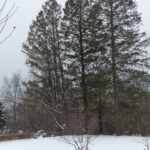
-
This year snow covers the lawn.



























